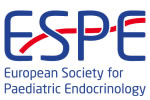hrp0089p1-p049 | Diabetes & Insulin P1 | ESPE2018
Life Changing Decisions due to Etiological Genetic Diagnosis in Families of Children with Maturity Onset Diabetes of the Young (MODY)
Bril Gherta , Vaxillaire Martine , Gruber Noah , Mazor-Aronovitch Kineret , Ben-Ami Michal , Ben-David Rachel Frumkin , Yeshayahu Yonathan , Sand Olivier , Bonnefond Amelie , Froguel Philippe , Pinhas-Hamiel Orit
hrp0086fc15.1 | Late Breaking | ESPE2016
NR5A1 is a novel disease gene for 46,XX testicular and ovotesticular disorders of development
Baetens Dorien , Stoop Hans , Peelman Frank , Todeschini Anne-Laure , Rosseel Toon , Coppieters Frauke , Veitia Reiner , Looijenga Leendert , De Baere Elfride , Cools Martine
hrp0086p1-p799 | Syndromes: Mechanisms and Management P1 | ESPE2016
NPR2 Gene Mutations Associated with Acromesomelic Dysplasia Maroteaux Type are Mostly Unique to Families
Castro-Feijoo Lidia , Barreiro Jesus , Guillen-Navarro Encarna , Journel Hubert , Wakeling Emma , Jagadeesh Sujatha , LeMerrer Martine , Silva Paula , Cabanas Paloma , Pombo Manuel , Loidi Lourdes
hrp0082p2-d3-350 | Diabetes (2) | ESPE2014
Wellbeing of Adolescents with Type 1 Diabetes: Influence of Metabolic Control and Family Factors
Vanbesien Jesse , Berlanger Laurence , Bohler Susanne , Laridaen Jolien , Gies Inge , Van Aken Sara , De Waele Kathleen , Cools Martine , Maris Ellen , Vanderfaeillie Johan , De Schepper Jean
hrp0082p2-d1-564 | Sex Development | ESPE2014
46,XY Neonates and Infants with Ambiguous Genitalia: Who to Investigate?
Baetens Dorien , Mladenov Wilhelm , Chiaie Barbara Delle , Desloovere An , Iotova Violeta , Menten Bjorn , Van Laecke Eric , Hoebeke Piet , De Baere Elfride , Cools Martine
hrp0084p3-1102 | Pituitary | ESPE2015
Clinical Characteristics of Children with Congenital Combined GH Deficiency without Associated Syndrome in Belgium
Zeevaert Renate , Verlinde Franciska , Thomas Muriel , De Zegher Francis , Cools Martine , Heinrichs Claudine , Beauloye Veronique , France Annick , Lebrethon Marie-Christine , Massa Guy
hrp0094fc8.2 | Neuroendocrinology | ESPE2021
Recessive PRDM13 mutations result in hypogonadotropic hypogonadism and cerebellar hypoplasia
Gregory Louise C. , Whittaker Danielle E , Oleari Roberto , Quesne-Stabej Polona Le , Williams Hywel J. , UCL GOSgene , Torpiano John G , Formosa Nancy , Cachia Mario J. , Field Daniel , Lettieri Antonella , Ocaka Louise , De Martini Lisa Benedetta , Rajabali Sakina , Riegman Kimberley L. , Paganoni Alyssa J.J. , Chaya Taro , Robinson Iain C.A.F. , Furukawa Takahisa , Cariboni Anna , Basson M. Albert , Dattani Mehul T. ,
hrp0092p1-155 | Thyroid | ESPE2019
Congenital Hypothyroidism Newborn Profile After a Lower TSH Cutoff for Neonatal Screening in Southern Brazil
RIZZOTTO MARCIA INES BOFF , Kopacek Cristiane , de Castro Simone Martins , Ribeiro Sabliny Carreiro , Madi Jose Mauro , Garcia Rosa Maria Rahmi
hrp0086p1-p45 | Adrenal P1 | ESPE2016
Polymorphisms Analyze in Gene CYP21A2 Gene Associated with Congenital Adrenal Hyperplasia
Jorgens Prado Mayara , Maria Dornelles da Silva Claudia , Grandi Tarciana , Martins de Castro Simone , Kopacek Cristiane , Lucia Rosa Rossetti Maria
hrp0082p3-d1-709 | Diabetes | ESPE2014
Continuous Subcutaneous Insulin Infusion Therapy in Preschool Children with Type 1 Diabetes Mellitus
Moinho Rita , Martins Dora , Almeida Angela , Maia Estefania , Batista Nanci , Aveiro Lina , Capitao Rita , Cardoso Rita , Dinis Isabel , Mirante Alice



